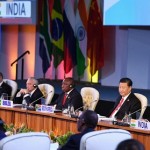In the age of Twitter, BRICS, or the grouping of Brazil, Russia, India, China and South Africa, has produced a 102-paragraph-long Johannesburg Declaration, one of the longest in recent years. This implies that either this important multilateral grouping has a lot to say about the state of the world or it needs to hire a sharp editor.
It is prudent to proceed on the first assumption. There is little doubt that BRICS has grown in influence, expanded the arc of its interests, and established new institutions and partnerships in its first decade. More importantly, it has created for its members the habits of working together. Intra-BRICS cooperation is on a rising trajectory.
Yet, the fact remains that BRICS is still far from achieving its initial goals: reform of global financial governance, democratisation of the United Nations, and expansion of the Security Council — partially because two of its members (China and Russia) do not want the other three members (India, South Africa and Brazil) to obtain parity in the global pecking order.
Summit highlights
In this backdrop, the 10th summit, held last week, framed its deliberations against U.S. President Donald Trump’s unconventional approach on world affairs, particularly the looming trade wars. “The summit is about the context,” said Maxim Oreshkin, Russia’s Economy Minister. “We are at a time when the U.S. and China announce new measures almost every week.”
BRICS leaders, therefore, stressed “the centrality of the rules-based, transparent, non-discriminatory, open and inclusive multilateral trading”, based on the World Trade Organisation. This stemmed from their broader commitment to cooperate for strengthening multilateralism, the rule of law and an equitable international order. That one of the BRICS members (China) does not follow in word and spirit this high-sounding prescription in regard to Asian affairs may have escaped attention.
The other big idea emanating from the summit is to help nations to prepare for the Fourth Industrial Revolution. South Africa, as the host, zoomed in on it early and managed to create sufficient enthusiasm for it. Participants embraced it, articulating the need for a new strategy on employment, education and skill development as the digital revolution unfolds. BRICS Partnership on New Industrial Revolution (PartNIR), however, will make a meaningful contribution only if it goes beyond the five ministries of industry. It should engage with the private sector and young innovators working at the cutting edge of technology today.
The summit saw further consolidation of the business pillar. The BRICS Business Council has been actively enhancing trade and economic cooperation in diverse sectors ranging from manufacturing and energy to financial services and regional aviation. Besides, the leaders renewed their commitment to an inclusive and “people-centred approach” on development. The steady progress in interactions through sports, films, education, culture and tourism has been commendable.
Africa, BRICS Plus
The BRICS outreach to Africa began at the last summit hosted by South Africa, in 2013; it has picked up momentum now. But African leaders want more. They need big loans from the New Development Bank (NDB) for their infrastructure projects. A South African official stated that this would happen soon but uncertainty persists. So far, the NDB has dispersed loans totalling $5.1 billion — all to its members only.
China introduced the “BRICS Plus” format at the Xiamen summit last year by inviting a few countries from different regions. South Africa emulated it, arranging the attendance of top-level representation of five nations of its choice: Argentina, Jamaica, Turkey, Indonesia and Egypt. The precise role of “BRICS Plus” countries will take time to evolve. An immediate benefit is the immense opportunities it provides for networking among leaders. A large number of bilateral meetings took place on the summit’s sidelines. For us, the most important was the interaction between Prime Minister Narendra Modi and Chinese President Xi Jinping, the third in four months, which deepened the trend towards conciliation between Asia’s two biggest powers.
Unity and divergence
As a partnership that represents over 40% of the world’s population and accounts for 22% of global GDP, BRICS will continue to be an influential voice as long as its convergences prevail over its divergences. Changing power equations within BRICS are being watched closely. China’s dominance is a reality even as the grouping asserts the sovereign equality of all members. China-Russia proximity has been a continuing factor. Given its political and economic travails, Brazil played a low-profile role.
Mr. Modi and his delegation were pro-active and visible. A South African commentator observed that India was playing “a delicate geopolitical game with the U.S., China and Russia as their spheres of influence wax and wane” across regions. To Delhi’s satisfaction, four paragraphs in the summit declaration were devoted to the problem of international terrorism. But no decision was taken to set up the BRICS credit rating agency that India favours. The India-South Africa partnership helped to ensure that the Johannesburg Declaration was balanced and well-rounded in its orientation.
The critical question is whether BRICS’s exertions will have appreciable impact on G-7, the grouping of the developed countries, which is in disarray, and particularly on the U.S. administration.
Rajiv Bhatia is Distinguished Fellow, Gateway house. A former high commissioner to South Africa, he writes regularly on BRICS-related developments.
This article was originally published by The Hindu. Click here to view the original article.


